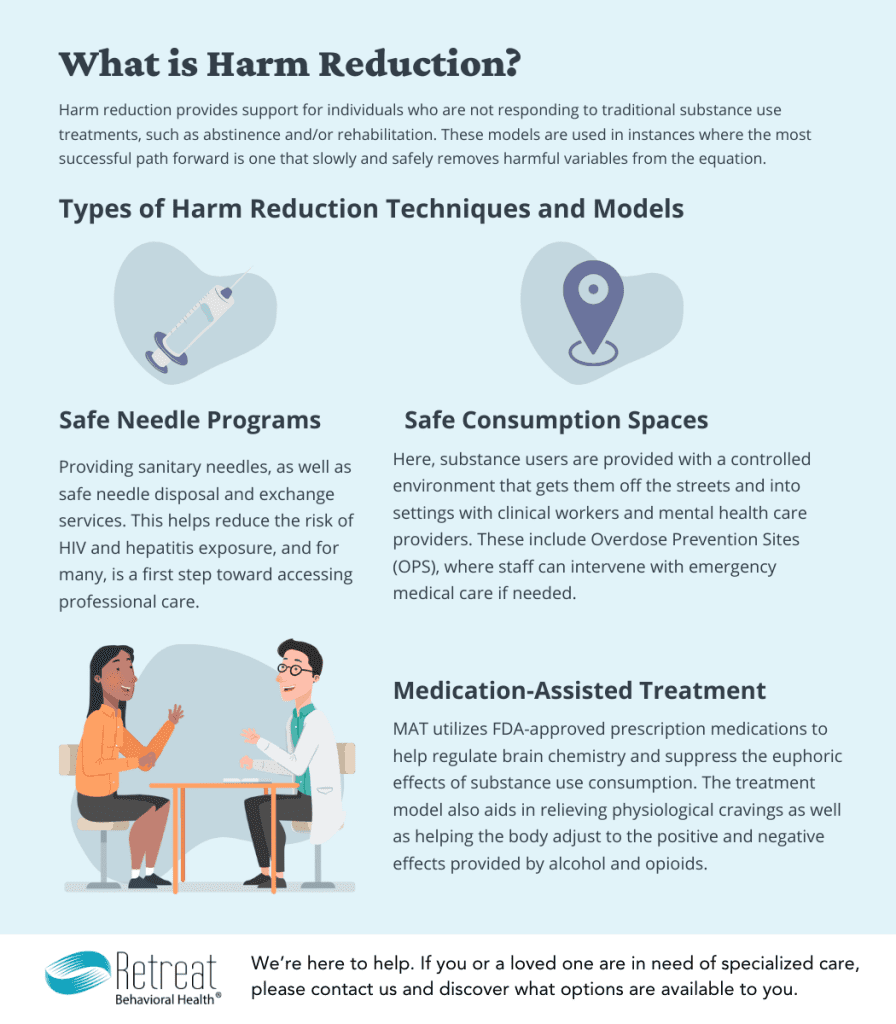What is Harm Reduction and How Does it Apply to Substance Use Treatment?
You may have heard the term “harm reduction” applied to substance use treatment, but what is harm reduction, and how can it help individuals on their path to recovery?
In light of the current administration’s support for it—including sanitary drug paraphernalia programs—we thought it was important to give a deeper look at the harm reduction model, including its application to substance use treatment. Here’s what you should know.
What is Harm Reduction?
Harm reduction provides support for individuals who are not responding to traditional substance use treatments, such as abstinence, rehabilitation, and standard modes of relapse prevention. The intent is to limit risk as much as possible. There is no universal definition or program that covers the depth of harm reduction in all aspects. For example, safe needle and syringe exchange programs provide a gradual, step-down approach to sobriety that acknowledges some people may not be ready for sober living while Medication-Assisted Treatment (MAT) is utilized to help sustain recovery through the use of medication supplemented with counseling and behavioral therapies.
Principles of Harm Reduction
The idea of harm reduction in substance use treatment first originated in the early 1970s with the opening of the country’s first methadone clinics. Methadone, a synthetic drug similar to morphine, was (and continues to be) used as a way to reduce intake of heroin and other narcotic drugs in individuals unable to stop in other ways. Since its origination – and opioid use became more common – other semi-synthetic drugs, such as buprenorphine and buprenorphine/naloxone also started being used; these ones specifically as a tool for opioid harm reduction.
These substances, along with others, are part of a model known as Medication-Assisted Treatment (MAT), a type of harm reduction that is prescribed by professionals in a clinical setting. Along with other methods of harm reduction that we’ll look at below, MAT is used to treat substance use disorders as well as sustain recovery and prevent overdose.
In addition to MAT, other harm reduction models like safe needle programs and safe consumption sites provide individuals struggling with substance use disorder safe drugs, sanitary drug paraphernalia, and clinical oversight. These safe consumption sites also provide these individuals the first step to learning more about substance use disorder programs, as well as providing them education on how to practice drug use on a safer scale.
Types of Harm Reduction
When we talk about what harm reduction is, what we’re really talking about is specific therapeutic practices in substance use treatment. This is an important distinction to note since while the goal with all substance use treatment is to reduce the harm of drug and alcohol use and help individuals achieve sobriety, harm reduction as a therapeutic model isn’t the go-to method for all individuals. Rather, these techniques are used in instances where traditional methods have failed, and where the most successful path forward is one that slowly and safely removes certain variables from the equation.
Here are the most common types of harm reduction used today:
Safe Needle Programs
These programs provide sanitary needles for intravenous drug users, as well as safe needle disposal and exchange services. This helps reduce the risk of HIV and hepatitis exposure from exposure to unclean needles, and for many, is also a first step toward accessing professional care.
Safe Consumption Spaces
At safe consumption spaces, substance users are provided with a controlled environment that gets them off the streets and into settings with clinical workers and mental health care providers. These include Overdose Prevention Sites (OPS), where staff can intervene with medical care in emergency situations and can also check substances for fentanyl and other highly fatal ingredients.
Medication-Assisted Treatment (MAT)
As discussed above, MAT utilizes FDA-approved prescription medications to help regulate brain chemistry and suppress the euphoric effects of substance use consumption. The treatment model also aids in relieving physiological cravings as well as helping the body adjust to the positive and negative effects provided by alcohol and opioids. Known as the “whole-patient” approach, MAT is a custom-made program created to meet the needs of each individual seeking treatment. There is no maximum recommended time to seek MAT, in fact seeking MAT indefinitely can be a choice made by an individual in long-term recovery and it would not be deemed medically inappropriate.
Harm Reduction & MAT at Retreat Behavioral Health
At Retreat, we offer MAT in addition to other substance use treatment options. Our clinically driven MAT programs are tailored to meet each individual’s needs. The ultimate goal of our MAT programs at Retreat is full recovery – that does not mean drug-free, it means addressing the whole person and their functioning life in society.
If you or a loved one are in need of care, please visit our admissions page and contact us today for a consultation.





